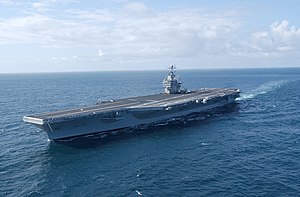 USS John C. Stennis underway off the coast of southern California
| |
| History | |
|---|---|
| Name | John C. Stennis |
| Namesake | John C. Stennis |
| Awarded | 30 June 1988[1] |
| Builder | Northrop Grumman Newport News[1] |
| Cost | $4.5 billion |
| Laid down | 13 March 1991[1] |
| Launched | 13 November 1993[1] |
| Sponsored by | Margaret Jane Stennis Womble |
| Commissioned | 9 December 1995[1] |
| Homeport | Norfolk |
| Identification |
|
| Motto | Look Ahead |
| Status | in active service |
| Notes | Ship in RCOH (Refueling and Complex Overhaul) |
| Badge |  |
| General characteristics | |
| Class and type | Nimitz-class aircraft carrier |
| Displacement | 103,300 tons[2][3] |
| Length |
|
| Beam |
|
| Draft |
|
| Propulsion |
|
| Speed | 30+ knots (56+ km/h; 35+ mph)[6] |
| Range | Unlimited distance; 20–25 years |
| Capacity | 6,500 officers and crew (with embarked airwing)[1] |
| Complement |
|
| Sensors and processing systems |
|
| Electronic warfare & decoys |
|
| Armament |
|
| Armor | Unknown |
| Aircraft carried | 90 fixed wing and helicopters |
| Aviation facilities |
|
USS John C. Stennis (CVN-74), named for Senator John C. Stennis of Mississippi, is the seventh of the Nimitz-class of nuclear-powered supercarriers in the United States Navy.
She was commissioned on 9 December 1995. Her home port is temporarily Norfolk, Virginia, for her scheduled refueling and complex overhaul (RCOH), which began in 2019. After her overhaul is completed sometime in the 2020s, she is scheduled to return to Bremerton, Washington.
- ^ a b c d e f "USS John C. Stennis". Naval Vessel Register. Retrieved 18 December 2010.
- ^ Polmar, Norman (2004). The Naval Institute guide to the ships and aircraft of the U.S. fleet. Annapolis: Naval Institute Press. p. 112. ISBN 978-1-59114-685-8.
- ^ "CVN-68: NIMITZ CLASS" (PDF).
- ^ Kuperman, Alan; von Hippel, Frank (10 April 2020). "US Study of Reactor and Fuel Types to Enable Naval Reactors to Shift from HEU Fuel". International Panel on Fissile Materials. Archived from the original on 5 October 2021. Retrieved 26 February 2022.
- ^ Hanlon, Brendan Patrick (19 May 2015). Validation of the Use of Low Enriched Uranium as a Replacement for Highly Enriched Uranium in US Submarine Reactors (PDF) (MSc). Massachusetts Institute of Technology. Archived (PDF) from the original on 9 October 2021. Retrieved 26 February 2022.
- ^ Gibbons, Tony (2001). The Encyclopedia of Ships. London, United Kingdom: Amber Books. p. 444. ISBN 978-1-905704-43-9.